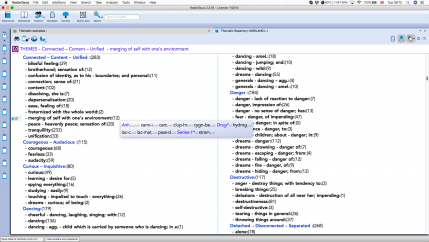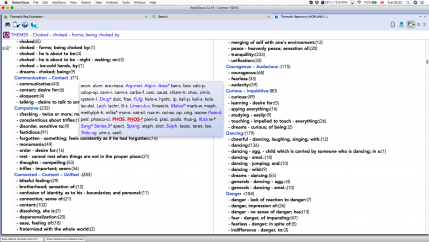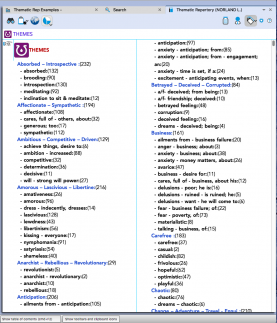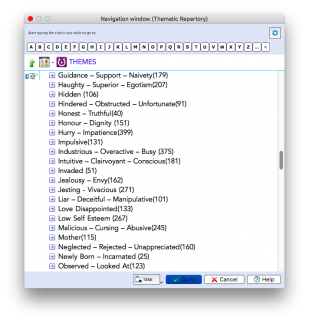Thematic Repertory by Luke Norland
Analyze remedies and families on the fly with 92 themes and over 850 individual rubrics. This supplement to Synthesis will help you find and analyze classical & modern remedies and families – with speed and simplicity
The Thematic Repertory does the hard work of grouping similar Mind rubrics for you:
- Developed by carefully combining cross-referenced Mind rubrics in Synthesis that express a similar meaning.
- Featuring additions of new remedies from contemporary Hahnemannian provings as well as remedy families.
- New remedies have been added by researching each theme throughout the provings available in RadarOpus.Check out this tutorial: Thematic Repertory – Introduction & Case example
Ever unsure which specific rubric to use?
- E.G. When anticipation is a problem for the patient, do you choose ailments from anticipation, anxiety from anticipation, anxiety – if a time is set or something else?
- Now you can simply take the Theme – Anticipation.

The navigation window shows which rubrics were used to compile the super-rubric
Unique features of the Thematic Repertory:
- Each theme lists the individual rubrics used to compile the super-rubric for transparency.
- You can choose to repertorise with these smaller rubrics too.
For example, in the theme “Changeable”, the following similar rubrics were combined to create the super-rubric

Some new remedies included in the Thematic Repertory are:
- New School of Homeopathy Provings – Clupea harengus (Atlantic herring), Latex vulcani (Vulcanized rubber),Passer domesticus (House sparrow), Meles meles (European badger), Carbo fullerenum (Carbon 60), Fulgurite (Lightning-struck sand), Cladonia rangiferina (Reindeer moss), Monotropa uniflora (Indian pipe), Slate of north wales.
- Other new remedies include – Lamprohyza splendidula (Firefly), Culex pervigilans (Mosquito), Banisteria caapi (Ayahuasca), Tyto alba (Barn owl feather), Calopteryx splendens (Damselfly), & more.
- You can use the RadarOpus search tool to find rubrics for any remedy, for example Aranea ixobola:

Some families included are:
Trees, Birds, Spiders, Milks, Periodic Table Series and Stages, Miasms, Sea animals, Butterflies, Insects, Fungi, Various Plant families, Noble gases, Mineral salts, Mappa Mundi elements & temperaments and more.
For example, below are the Bold-type themes of the Birds:

Families are added according to the following criteria:
- When 3 or more remedies from a family are found within a rubric.
- According to the author’s knowledge of family themes based on a variety of teachers (mentioned below) & confirmed in cases.
With the Thematic Repertory you can:
- Limit your analysis to show only families instead of remedies.
- Do a search extraction to see the themes of families & remedies.
- Check the original author code from Synthesis.
“The Thematic Repertory is a new work based on additions I have made to the Mind chapter of Synthesis. It is inspired by Jeremy Sherr’s pioneering Q Rep & Mirilli’s Themes. There are 92 Themes and over 850 individual rubrics contained in it. Families of remedies are included alongside many new remedies from recent Hahnemannian provings. I hope this work will help homeopaths to navigate the inherent difficulties of finding the most precise rubric to represent complex mental/ emotional states. I would like to acknowledge and thank the following teachers: Janet Snowdon, Jonathan Hardy, Geoff Johnson, David Mundy, Misha Norland, Jeremy Sherr, Jan Scholten, Peter Fraser, Rajan Sankaran, Massimo Mangialavori, Anne Vervarcke, Michal Yakir, the Joshis.” ~Luke Norland BMus DSH RSHom
“Hi Luke. Just wanted to drop you a line saying how useful I’m finding your thematic rep. As I am using Michal Yakirs plant evolution model more and more to guide me to where to look for the similimum, I find the broad concepts and large rubrics of the thematic rep complement my search – thank you.” ~Geoff Johnson MA Vet MB MRCVS VetMFHom RSHom PCH
Click on the images for a guided tour of the Thematic Repertory!



















